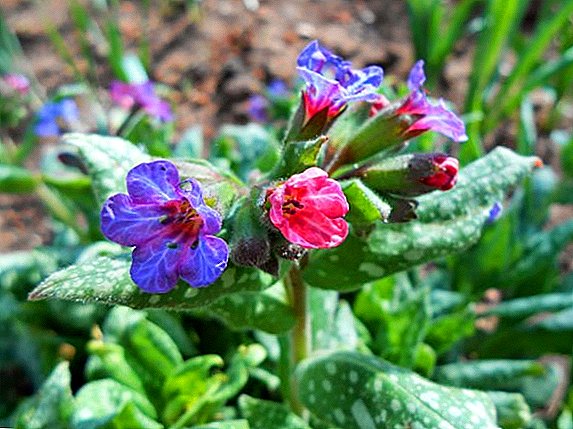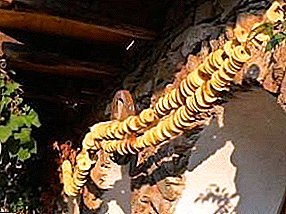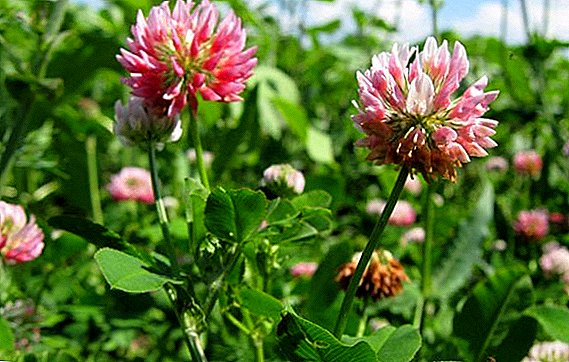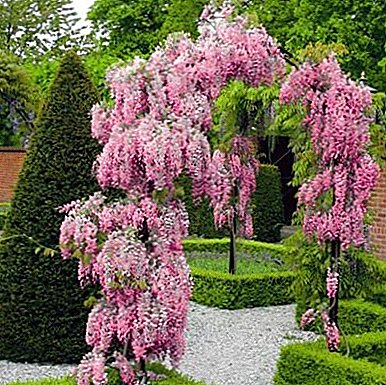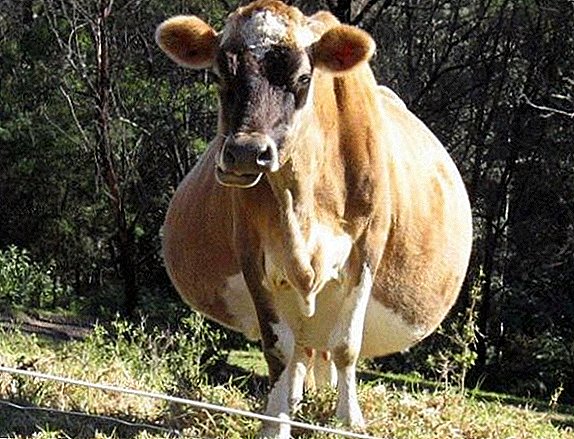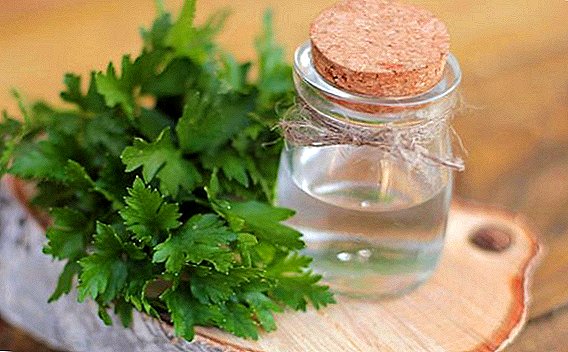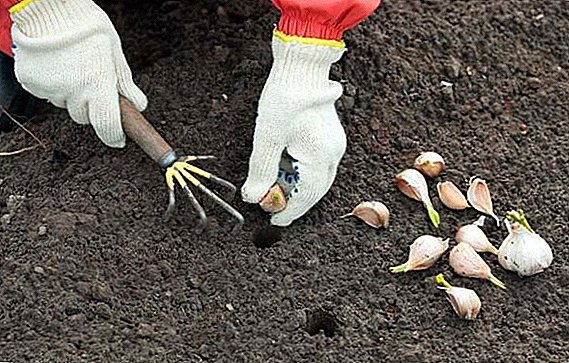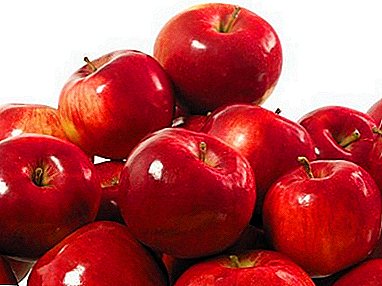
Anis Scarlet - one of the viable and carefully cultivated Russian varieties of apples.
The most popular version of its origin is the variant of a successful combination of an imported cultivar and some kind of apple-wilderness that grew on the right bank of the Volga.
The veracity of this version is confirmed by the similarity of the shape of the leaves, shoots and the general structure of the tree.
Then you will read the description of the Anis Scarlet variety and see the photo of the fruit and what the apple tree looks like.
What kind is it?
 The variety during its existence has spread widely throughout the Volga region.
The variety during its existence has spread widely throughout the Volga region.
What contributed to its excellent indicators of winter hardiness and drought resistance, thanks to which the anise scarlet is counted among the apple trees late autumn ripening.
By the autumn varieties are: Anise Sverdlovsk, Altai scarlet, Sic Sanguineous, Borovinka, Volzhanka, Jonathan, Dessert Petrova, Long (Kitaika) Zhigulevskoye, Imrus, Calvillo snow, Kutuzovets, Junior Naturalist, Assumption, Sweet, Prima, Freshness, Rock, Sunny, Bellefleur Kitayka, Cinnamon Striped, Cinnamon New.
Variety description Anis Scarlet
Consider separately the appearance of the apple and its fruit.
Tree:
- Development in temperate climate in combination with the history of the "wild" ancestors allows Anis to grow to a decent size - on average 6-7 meters.
- The crown of the tree has wide pyramid shapewhose diameter at the base can be up to 7-8 meters.
- Strong, well developed stem and medium size neat leaves are egg-shaped with a rich dark green color.
- Tree begins to fructify in the fifth year of my life.
Fruit:
 The size of the fruit depends on the age of the tree: on young apples of medium size, with the age of the apple tree, they begin to shrink.
The size of the fruit depends on the age of the tree: on young apples of medium size, with the age of the apple tree, they begin to shrink.- The standard weight of an apple is 80-100 g
- The shape of the apple is round, smooth, occasionally there is a slight ribbing.
- The funnel for the short stem is wide, with well-defined depth.
- The shiny skin of the fruit is smooth, the color is pale yellow with a blurry veil of scarlet blush. The color is smooth, without clearly marked spots or stripes, carefully covered with thick dense wax coating.
- On cut, the skin is pale greenish.
- The flesh of an apple has a light greenish tint.
- Like most late-ripening varieties, the flesh is dense, crunchy, with a pronounced sour-sweet taste with almost no smell.
- Ripening apples in the beginning of autumn perfectly transport and storage.
A photo







Breeding history
Anise is one of the oldest varieties of ennobled wild Volga apple trees. The perennial cultivation and cultivation of the rock on different soils allowed us to create more than fifty different anise varieties.
 Since the end of the nineteenth century, many new types of crossbreeding classic anise with local wilderness have been presented at international exhibitions of plant breeding and fruit growing in Russia.
Since the end of the nineteenth century, many new types of crossbreeding classic anise with local wilderness have been presented at international exhibitions of plant breeding and fruit growing in Russia.
Today, pure varieties of Anis Scarlet (according to the State Register) can be found mainly in the North-West, Volga-Vyatka, Middle Volga regions.
Growing region
Anis Scarlet is most prevalent in the farms of the Volga region, but thanks to its excellent adaptive qualities it is easy to adjust to any Russian region, with the exception of the deep North.
Trees tolerate cold and drought, do not require particularly fertile soil (although with proper feeding the fruits are much bigger and juicier) and successfully grow even in hilly or mountainous areas.
These qualities of wood are possible due to well developed root systemlooking for the aquifer depth up to three meters. The frost resistance of scarlet anise is one of the highest among fellows.
For planting in this region are suitable varieties Antonovka Dessert, Aelita, Anis striped, Grushovka Winter, Kuibyshev, Apple Spas, Lobo, Yandykovskoe, Jubilee Moscow Stroevskoe, Christmas, Rossosh, North Sinap, Memory Ulyanischeva, Reinette Simirenko, Cliff, Red Early , Quinty, July Chernenko, Rennet Chernenko, Isetskoe later.
Yield
 With proper care, the tree grows on fertile soil or with annual top dressing. fifth year can give from 200 to 300 fruits.
With proper care, the tree grows on fertile soil or with annual top dressing. fifth year can give from 200 to 300 fruits.
In a weight ratio, depending on the region, the yield may be from 100 to 230 kg.
Storage conditions
Anis Scarlet, like others autumn varieties, does not lose the presentation until the end of December - mid January.
Careful storage requires adherence to a few simple rules:
- apple harvesting is carried out only in dry weather;
- prepared apples should not be washed or wiped, as this erases a thin wax layer of natural protection;
- container can serve wooden boxes, exposed in a cool place;
- each new layer of apples is laid with pastry parchment;
- You can fight the inevitable rot by adding dry onion peel to the crates.
Planting and care
In order for the apple tree to give a good harvest and not to undergo diseases, it is necessary to follow a number of recommendations.
 For the successful development of Anis Scarlet, it is advisable to choose fertile soils. on a sunny stretch of land.
For the successful development of Anis Scarlet, it is advisable to choose fertile soils. on a sunny stretch of land.
Pits for seedlings should be large enough with sheer walls, 1-1.25 cm wide, 0.5-0.6 m deep.
Fertilizers and additional feeding in the form of 25-35 kg of rotted manure and a little bit of superphosphate with wood ash.
When planting apple seedlings, the plant should be set so that root neck was 10 cm above the ground. After planting, the plant is carefully watered.
Apple trees are cultures, not demanding special care. Nevertheless, there are a number of rules that should be followed, wishing to increase yields.
One of the main points of care for Anis is obligatory thorough irrigation, especially in the first years of life, while the root system has not yet been fully formed.
The first watering should be done after the flowering period, repeating the procedure once a week.
In the middle apple enough 20-25 liters of water for one irrigation, although the volume of liquid may increase during hot, dry weather.
 In winter, the plant must be tied, as it protects against severe frosts and rodents. (however, even after frostbite, anise quickly recovers).
In winter, the plant must be tied, as it protects against severe frosts and rodents. (however, even after frostbite, anise quickly recovers).
To increase the yield, it is necessary to periodically form the crown and apply organic fertilizers.
Diseases and pests
Anise Scarlet is subject to the same diseases as most apple crops in the middle zone.
It:
Mealy dew - whitish plaque that affects young shoots, leaves and buds. The active development of the disease leads to drying out and falling off of both the leaves and the ovaries.
You can overcome the disease by using colloidal sulfur solutions or drugs "Skor" and "Topaz".
Scab - A fungal disease that occurs when excessive humidity and air stagnation. Scab affects both the leaves and the fruit of the tree. Manifested in the form of brown spots on the leaves and fruits.
 You can get rid of using the crown treatment solution urea or copper oxychloride fall or spring until the appearance of the ovary buds.
You can get rid of using the crown treatment solution urea or copper oxychloride fall or spring until the appearance of the ovary buds.
Anise scarlet is loved by Russian gardeners for unpretentiousness, resistance to low winter temperatures and good disease resistance.
Although this variety does not have a high yield, this disadvantage is compensated by the excellent juicy taste of the fruit.


 The size of the fruit depends on the age of the tree: on young apples of medium size, with the age of the apple tree, they begin to shrink.
The size of the fruit depends on the age of the tree: on young apples of medium size, with the age of the apple tree, they begin to shrink.